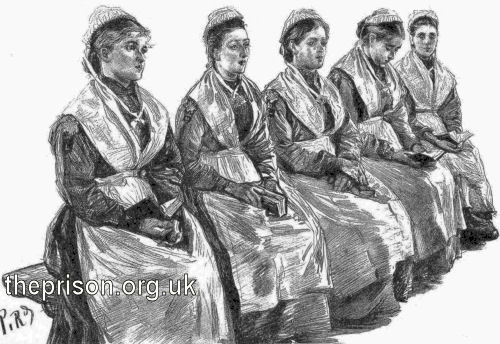Female Convict Life at Woking — IIII.
This is part three of a three-part article by F.W. Robinson published in September 1889 on life in the Woking Female Convict Prison. The accompany illustrations were by Paul Renouard. (Part One and Part Two are on separate pages.)
The best behaved female convicts are the "lifers" — the infanticides, "the star women," i.e., the convicts who are in for their first offence, and who bear as a distinguishing mark a star upon the left arm. Our artist has depicted a group of these stars — here are the young women who have preferred to destroy the lives of their infants rather than acknowledge the sin and shame which had brought them into being, who have been caught red-handed, tried, and sentenced, not a few of them escaping the gallows by a hair's breadth.
They are the best of prisoners at Woking, as elsewhere, many of them truly penitent women, thanks to the ministrations of the chaplain and the priest — they have no breaks-out, they do their allotted share of work uncomplainingly, and they are very often trusted implicitly by the authorities in kitchen-work, laundry-work, and cleaning-work, and in those little special missions which crop up occasionally, and which it would savour of insanity to delegate to any one of the regular convict pattern.
These infanticides are really branded, or labelled, with two stars, like a second-class quality of Henessey's or Martell's cognac. The red star under the other is significant of "murder most foul;" it is affixed to a kind of black cloth badge, on which is also enumerated the number of their "register," and a second number under the star to indicate the length of time the convict has to serve. If the sentence he life, the single letter "L," in lieu of a number, tells the grim story to all whom it may concern. Were this a critical essay — which it is not — one might feel disposed to question the advisability of this, and to speculate as to the various reasons for thus publicly branding the blackest of the sheep; but we do not learn that there is any protest anywhere against the rule, and in all instances it appears to work satisfactorily. The women do not resist it, or rebel against it — it is part of their fate, these scarlet stars.
Looking in upon them in the great prison-kitchen — where we taste the soup and bread and pudding under their observant eyes — it is almost impossible to associate with these fair faces and grave looks the awful crime for which they are doing penance. They are so different in appearance from the ordinary convict; one misses at once the heavy jowl, the sunken eyes, the retreating chin or the over-solid chin, and the low, pent-house forehead of the old penitentiary hand.
There are some strange stories to be told of the infanticides — the red stars — stories of romance and tragedy that the novelist has not dreamed of yet, wild realities of life that in fiction would have been dubbed at once by a scandalised critic as highly improbable, and utterly untrue to human nature in every respect.

Red Star' women undergoing life imprisonment for infanticide, Woking Female Prison, 1889.
Some ten or twelve years ago one of the infanticide class was the leading character of a little romance. Matrons long in service at Woking, and matrons long past service, may remember one very pretty and well-behaved female convict who had been a nursemaid in a gentleman's family, and who it was said had been "led away" by the eldest son. She was tried, and found guilty of the murder of her infant, whose body was discovered, we understand, several months after the perpetration of the crime. The woman confessed to the murder, and was in due course transferred to Woking. She was an exceptionally good prisoner, had been evidently well-educated for her station in life, and seemed altogether of a different class to the majority of those by whom she surrounded. Matrons of prisons are not impressionable beings, but they were prone to make a story — even a mystery — out of this young woman, and this was enhanced by the behaviour of those who came at the allotted periods of time — every three months as a rule to visit her. Her visitors were not those of her own family, but her late mistress and daughters, who generally arrived in a Carriage and pair with much outward show. There was evidently considerable sympathy and even affection between the servant and the family, and the greatest kindness of manner was exhibited, even an extraordinary kindness, that begat suspicion, in more than one matron on duty at different times in the visiting room, as to the pressed reason for excitement it all. The prisoner suffered a great deal from suppressed excitement before and after a visit, but was tolerably calm on the occasion itself, asking many questions, enquiring after the health of "Dear Fred," and evincing a very marked interest also in the welfare of a certain absent member of the family. "She never comes," was said reproachfully even. "She is not well," was the explanation. "I would have come to see her," was the quick reply to this.
To the imaginative mind of one officer, all this was a story of self-sacrifice, self-abnegation; and a fear that the woman was undergoing a penalty for another's crime, was more than once expressed, and whispered amongst the matrons at the mess room table. On one occasion "Dear Fred" wrote to her — "Dear Fred," who complicated the story not a little, and whom no one could make out, from the small basis there was to judge of his seductive capabilities. He wrote a very calm and unlover-like epistle — as was natural enough considering that official eyes would take stock of every word of his composition before delivering it to the prisoner, but he wound up with a piece of news for her "Amelia is no longer a gushing girl," he wrote. Who was Amelia, and what had she to do with this little prison tragedy?
Although, as a rule, the women who have taken life are the best behaved of female convicts, and generally occupy the more responsible posts of the prison, there are exceptions to the rule. Not a very striking exception, however, was a female convict to whom we will now refer, one whose trial and sentence was a cause célèbre in its day, the subject of innumerable leading articles and heated discussions, and whose name we will not mention here, as the gates have been opened to her, and her liberty granted after long years of prison servitude. She was a young lady by birth, and many reams of sentimental literature have been spun over the theory of her crime and her after confession, but she was far from sentimental in Woking Prison — on the contrary, as matter of fact and as crafty, and as quick to secure a privilege, as any of her sister convicts. She was seldom punished for insubordination, and she took her place amongst the kitchen-women after her probationary period had expired. She was no favourite with her contemporaries, and was not greatly like by the officers, but she plodded on in her various tasks fairly well. It was in the wind, probably, that a pardon might in due course be extended to her, for it was noticed that she was scrupulously particular in keeping her hair in a bunch under her cap, in order, it was said spitefully by her fellow-prisoners, to save her parting when she got out.
To her credit, it may be said, that she once took upon herself, in association, to reprove a prisoner who mentioned that she loathed and despised everybody in the service who had turned a key upon her — that she hated them all, and wished them all dead, from the lady-superintendent downwards. This was at the period when Mrs. Gibson was lady superintendent of Woking Prison, and before the present governor came into office.
"What has the lady-superintendent to do with it?" asked the subject of our present remarks, "she does not turn the key upon anybody. It is not fair, because she is put in authority over us, for any one to hate her." But the other was not so sure upon the point, she hated everybody, she did, "most consumedly."
Our special prisoner had an excellent appetite, and did not in any way or at any time appear to be a prey to remorse for a crime which had had especially appalling features connected with it. She was an argumentative prisoner, and business-like to the very last — a hard kind of being, watchful and jealous, and even cruel. She took considerable pleasure in killing a rat when the chance presented itself, which it did occasionally, and her appetite was so good that she has been known, when on kitchen service, to help herself to an extra modicum of cocoa, by drinking surreptitiously from a saucepan lid that was handy. She stood very much upon her rights, and was especially jealous of any convict whom she thought more favoured by the officers than she was. This was one of her chief troubles whilst undergoing penal servitude. A little while before Her Majesty's pardon was extended to her she was so mortified at what she considered the extra privileges conceded to one well-behaved woman in the kitchen division that she seized an opportunity to pin to her back a paper on which she had contrived to write:—"This is the model woman."
F. W. ROBINSON
Links
Except where indicated, this page () © Peter Higginbotham. Contents may not be reproduced without permission.



